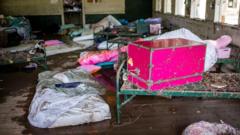Did Camp Mystic Buildings Just Get Removed from the Flood Map?

Understanding the Flood Risk Regulations and the Tragic Events at Camp Mystic
The devastating floods that struck Texas, claiming the lives of 27 young children at Camp Mystic, have raised numerous questions about the adequacy of flood risk management and regulatory measures. Reports indicate that U.S. regulators may have altered flood risk maps, thereby potentially undermining the safety of the camp and its vulnerable occupants. This situation highlights the critical need for robust flood risk assessments, transparent communication, and stringent regulations, especially when it comes to areas frequented by children. In this article, we will explore the intricacies of flood risk mapping, the implications of regulatory decisions, and the essential considerations for safeguarding communities against such tragedies.
The Importance of Flood Risk Maps
Flood risk maps are essential tools that help communities understand the potential dangers posed by flooding. These maps provide insights into which areas are most susceptible to floodwaters, enabling local governments and residents to make informed decisions about land use, construction practices, and emergency preparedness. The Federal Emergency Management Agency (FEMA) produces these maps based on various factors, including historical flood data and geographical features.
How FEMA Creates Flood Risk Maps
FEMA employs a multi-step process to develop flood risk maps:
- Data Collection: FEMA gathers extensive data regarding rainfall patterns, topography, and historical flooding events.
- Risk Assessment: Using the collected data, FEMA analyzes areas to determine their flood risk based on a range of factors.
- Mapping: The agency then creates detailed maps that categorize areas into different risk zones, such as high-risk flood zones, moderate-risk areas, and low-risk zones.
- Public Feedback: FEMA allows communities to review proposed maps and provide feedback, which can lead to revisions based on local insights.
These maps serve crucial roles in urban planning, insurance requirements, and emergency response strategies. Unfortunately, when inaccuracies or alterations occur, the implications can be dire, as tragically evidenced by the events at Camp Mystic.
The Camp Mystic Incident: A Case Study
Camp Mystic, located in a low-lying area along the Guadalupe River, had long been a beloved summer retreat for children. However, the camp's location also posed significant flood risks. In 2011, FEMA classified Camp Mystic as being in high-risk flood zones, indicating that strict regulations and flood insurance would be necessary to protect campers and property. However, records indicate that the camp successfully challenged these designations, leading to altered flood maps that seemingly reduced risk classifications for the site.
The Challenges Faced by Camp Mystic
Despite the alterations to the flood risk maps, evidence from FEMA's original maps indicated that parts of Camp Mystic were located within designated "floodways," areas particularly vulnerable to dangerous floodwaters. This situation presents several troubling issues:
- Regulatory Oversight: The decision-making process that led to the exemption of Camp Mystic raises significant concerns about transparency and the adequacy of regulatory oversight.
- Children's Safety: Given that Camp Mystic caters to children, one would expect heightened caution regarding flood safety regulations.
- Failure to Update Maps: Reports suggest that FEMA did not update maps to incorporate the camp's written appeals, which raises questions about the agency's responsiveness to local concerns.
In the wake of the floods, many are questioning whether enough was done to warn residents or evacuate camps prior to the disaster.
The Aftermath of the Flood
The tragic flooding incident not only resulted in the loss of young lives but also highlighted systemic flaws in how flood risks are managed and communicated. In addition to the 27 children who lost their lives, the broader Texas community faced immense devastation, with over 129 fatalities reported statewide and many more individuals still missing.
Government Response and Community Recovery
In the aftermath, President Donald Trump visited the affected areas, pledging government support for rebuilding efforts. His remarks emphasized the unprecedented nature of the disaster but also raised concerns regarding the adequacy of preemptive measures and community preparedness.
Lessons Learned: Improving Flood Risk Management
The harrowing events at Camp Mystic serve as a stark reminder of the importance of accurate flood risk assessments and proactive community planning. Several lessons can be gleaned to improve flood management strategies in the future:
1. Enhanced Regulatory Frameworks
There is a pressing need for more stringent regulations governing flood risk assessments, especially in areas frequented by children. Agencies must prioritize the safety of vulnerable populations over other interests.
2. Transparent Communication
Clear and open communication about flood risks is essential. Local governments and agencies must ensure that residents understand the risks associated with their locations and the measures in place to mitigate those risks.
3. Community Preparedness Programs
Implementing community preparedness programs can greatly enhance the ability of residents to respond to emergencies. This includes regular drills, educational campaigns, and accessible resources for flood preparedness.
4. Regular Updates to Flood Maps
To ensure accuracy, flood maps should be regularly updated to reflect changes in land use, climate conditions, and other factors that may influence flood risks. This includes considering the cumulative impacts of development on natural floodplain functions.
Conclusion: A Call for Action
The tragedy at Camp Mystic has opened the door for critical discussions about flood safety and the regulatory processes that govern flood risk assessments. As communities across the United States grapple with the increasing frequency and severity of flooding events, it is imperative that we learn from these tragic incidents to create safer environments for all, particularly for our children.
Moving forward, it is essential for policymakers, regulatory bodies, and communities to work collaboratively to enhance flood risk management strategies. By prioritizing transparency, safety, and proactive measures, we can help prevent future tragedies and ensure that vulnerable populations are adequately protected.
Frequently Asked Questions
What are flood risk maps and why are they important?
Flood risk maps are tools that designate areas based on their risk of flooding. They help inform local governments and residents about potential hazards, guiding decisions on construction, insurance, and emergency preparedness.
What happened at Camp Mystic during the flooding?
During severe floods, 27 children tragically lost their lives at Camp Mystic, which had previously been designated as a high-risk flood area. Changes to flood risk maps raised concerns about the safety measures in place.
How often are flood maps updated?
Flood maps should be updated regularly to reflect changes in land use, climate conditions, and other factors that could influence flood risks. However, the frequency of updates can vary depending on local priorities and resources.
What steps can communities take to prepare for potential flooding?
Communities can implement preparedness programs that include educational campaigns, regular emergency drills, and accessible resources that inform residents about flood risks and response strategies.
How can regulatory agencies improve flood risk management?
Regulatory agencies can enhance flood risk management by ensuring transparency in decision-making, prioritizing the safety of vulnerable populations, and regularly updating flood risk maps based on the latest data.
The devastating events at Camp Mystic serve as a call for action. It is essential to rethink our approach to flood risk management and ensure that safety is always the top priority. With growing climate challenges, how can we better protect our children and communities from such tragedies in the future? #FloodSafety #CommunityPreparedness #ChildSafety
Published: 2025-07-13 15:32:21 | Category: technology



